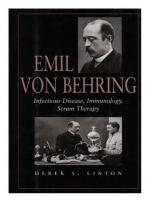|
This section contains 1,100 words (approx. 4 pages at 300 words per page) |

|
World of Microbiology and Immunology on Emil von Behring
Emil von Behring's discovery of the diphtheria and tetanus antitoxins paved the way for the prevention of these diseases through the use of immunization. It also opened the door for the specific treatment of such diseases with the injection of immune serum. Behring's stature as a seminal figure in modern medicine and immunology was recognized in 1901, when he received the first Nobel Prize in physiology or medicine.
Emil Adolf von Behring was born in Hansdorf, West Prussia (now Germany). He was the eldest son of August Georg Behring, a schoolmaster with thirteen children, and his second wife, Augustine Zech Behring. Although his father planned for him to become a minister, young Behring had an inclination toward medicine. One of Behring's teachers, recognizing both the great promise and meager circumstances of his student, arranged for his admission to the Army Medical College in Berlin, where he was able to...
|
This section contains 1,100 words (approx. 4 pages at 300 words per page) |

|


